
2015.2 | 2015.1 | 2014.2 | 2014.1
2013.2 | 2013.1 | 2012.2 | 2012.1 | 2011.2 | 2011.1 | 2010.2 | 2010.1
2009.2 | 2009.1 | 2008.2 | 2008.1 | 2007.2 | 2007.1 | 2006
August – December 2008
- December 2008 Newsletter – Dec 8
- October 2008 Newsletter – Oct 9
- August 2008 Newsletter – Aug 7
December 2008 Newsletter
Shows and Sales
Pala International News
Mineral and Mineralogy News
Shows and Sales
Tucson Time – February 4–15, 2008
After the holidays, we’re looking forward to the world’s greatest gem and mineral show in February. Highlights include:
- Display of American Gem Trade Association Spectrum and Cutting Edge Awards winning collections
- Smithsonian Institution Special Exhibit: Highlights from the home of the Hope Diamond travel to the AGTA GemFair, along with Jeffrey Post, Ph.D., curator of the National Gem Collection
- The theme of this year’s Tucson Gem and Mineral Show is “Mineral Oddities”
 |
See Pala International’s page on the Westward Look Show site.
Pala International will be represented in Tucson as follows.
Event: AGTA GemFair
When: February 4–9, 2009
Where: Tucson Convention Center
Booth: 1016–1018
Event: Westward Look Mineral Show
When: February 6–9, 2009
Where: Westward Look Resort
Suite: 236
Website: Official show website
Event: 55th Annual Tucson Gem and Mineral Show
When: February 12–15, 2009
Where: Tucson Convention Center
Booth: Aisle 5 East
We look forward to seeing our many friends there. Visit the Pala International Show Schedule for future events. [back to top]
Tucson Traffic Tips
Highway construction in Tucson will continue to impact travel. Use these resources to save yourself a headache.
[back to top]
Pala International News
Pala’s Featured Mineral Specimens: A New Influx of Mineral Oddities from Namibia
When we hear the phrase “Namibian minerals” we think of all the great carbonates from Tsumeb, Erongo aquamarines and fluorites, amethyst from Brandberg—the list goes on and on. But out of all the holes dug in this vast country, we haven’t seen all the unusual treasures Namibia has to offer. For instance, in the last year or so we have seen some new twists on some old favorite species from the Erongo region.
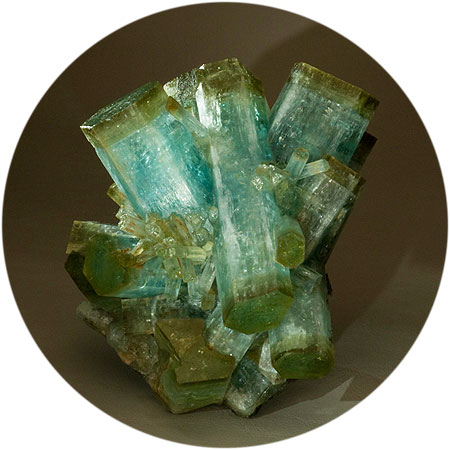 |
| Golden heliodor cap with a sharp contact next to the aquamarine shaft, 12.5 x 9.0 x 8.5 cm. Price available upon request. (Photo: Jason Stephenson) |
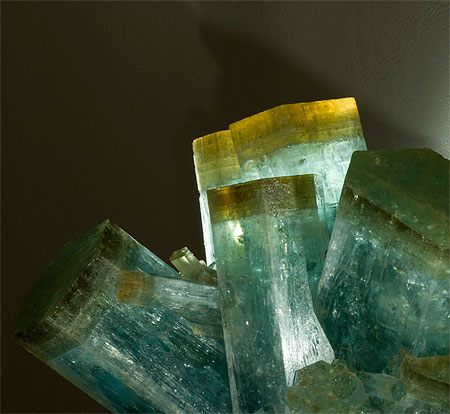 |
First we look at a heliodor-capped aquamarine cluster with big cigar-sized crystals. The center crystal is actually doubly terminated. Most faces and terminations are glassy and pristine. This specimen comes to us from Erongo, where most of the crystals with this unusual color scheme were limited to single crystals and miniature clusters. This specimen is most likely one of the largest produced from the area.
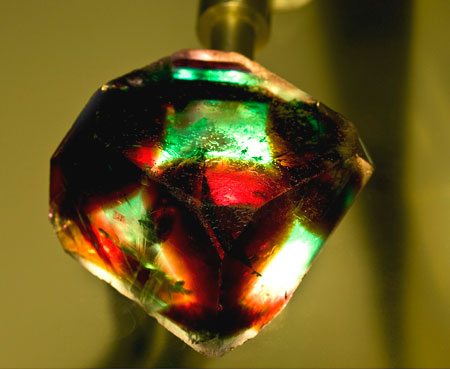 |
| Fluorite cube with phantoms, 6.0 x 6.0 x 4.5 cm. Price available upon request. (Photo: Jason Stephenson) |
Second is an alien-like fluorite cube with spooky green and red banding, creating phantoms. A limited number of these fluorites were found in Erongo from the appropriately named “alien pocket.” The material is very dark and only comes to life with bright transmitted light. The photograph above shows the fiber-optic light converging underneath the fluorite to accentuate the color and mask-like patterns. Several new alien-fluorite pieces will be available for sale; call or email us to inquire.
Rhoda and Dan Brock Collection
Pala International acquired the Rhoda and Dan Brock collection recently with the help of Casey and Jane Jones. At first glance the collection seemed like a pile of rocks left in a box in the garage, but upon closer inspection there were definitely some hidden jewels to be dusted off and examined: menagerie of local specimens from around San Diego County and into Mexico. Included are a few nice benitoites, cuprites, calcites, and several varietals of quartz.
Rhoda and Dan Brock Collection
A report by Jane Jones
Dan and Rhoda Brock began collecting minerals together shortly after their marriage in 1948 and collected until 1986 when they moved to Apple Valley, California. Sitting in Rhoda Brock’s collection room, a mineral specimen in her hand, becomes a touchstone for a story, many of them about her husband Dan who passed away in 1996. The breadth of their collection of minerals and gemstones exhibits more than their individual tastes; it also displays the extraordinary minerals that were coming out especially in the 1940s and 1950s.
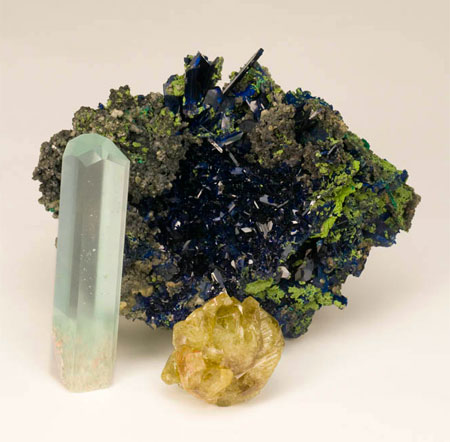 |
| No pile of rocks… Azurite cluster from Tsumeb, Namibia (11.5 x 9.0 x 4.5 cm., $1500), a greenish aquamarine from Brazil (7.2 x 1.75 x 1.5 cm., $1200), and a chrysoberyl from Brazil (3.6 x 3.0 x 2.2 cm., $1500). (Photo: Jason Stephenson) |
Rhoda and Dan were members of the Compton Gem and Mineral Club, California Federation of Mineralogical Societies. Dan Brock was chairman in 1957 when Compton hosted the CFMS show, and the first year the Smithsonian Institution exhibited minerals at a CFMS show. Rhoda displayed and competed at the CFMS shows; however, her memories and stories are of being in the field and collecting with friends and of the exhilaration a new find. They spent quite a bit of time digging on the dumps of the old Pala mines—beautiful specimens of kunzite, elbaite, and rubellite; and watermelon tourmalines that were discarded because they just weren’t up to the standards of the day.
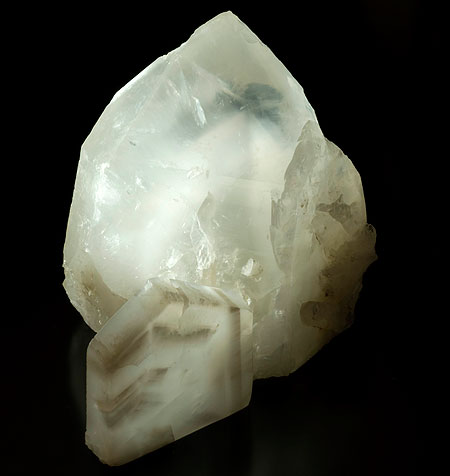 |
| Cat’s eye quartz crystal showing phantom and asbestos needles, 8.5 x 6.0 x 6.8 cm. Slice (front) shows the orientation of needles so cabochon-style cutting can concentrate the light into a sharp eye, 4.7 x 4.5 x 1 cm. Price available upon request. (Photo: Jason Stephenson) |
The best story, though, is of the extraordinary cat’s eye quartz find by Rhoda that was credited to her husband, Dan. John Sinkankas, in Gemstones of North America, credits Dan Brock with a new and significant find of chatoyant quartz in Arizona, which he describes in the following way: “The author can recall of no chatoyant quartz from any locality in the world in which the inclusions are so fine and so brilliantly reflective.” (Sinkankas, 1959, p. 375) The problem is that Rhoda found the pocket!
Here’s the tale: In 1956, friends from the Compton Club were collecting at the well-known Crystal Peak quartz locality in Yuma County. Dan and the others were hiking and scouting the hills above while Rhoda stayed in the “gully.” There was a little seam showing, so Rhoda started picking at it and digging with her Estwing hammer. Less than a foot under the surface a pocket opened up with lots of loose crystals in it. Later, when Dan showed some of the material to John Sinkankas, he assumed it was Dan that had found it. The last time Rhoda saw Sinkankas in Tucson in the late 1990s she joked with him about this—they perhaps agreed it was the way things were done back then.
The inclusions and phantoms and cat’s eye chatoyancy in this find distinguished them from the generally clear quartz from this location. One pure, white cut cat’s eye piece referenced by Sinkankas weighed 12.27 carats and measured 9/16 inch. One of the better pieces from this find was donated to the Smithsonian Mineral Collection. [back to top]
And Speaking of Cat’s Eye Quartz…
From the Brocks—via John Sinkankas
Pala’s Bill Larson recalls the following regarding another treasure unearthed by the Brocks.
I was lucky to meet the famous John Sinkankas as a young collector of 14. He led a small group of field collectors to Cecil Coles’s Benitoite Gem Mine, and he became a lifelong friend. John was indispensable in helping Pala International locate tourmaline pockets in the various mines we worked.
John chose me to purchase a major portion of his personal mineral collection in the 1970s. Then in the 1990s he called me and said, “You know Bill to be a well rounded collector you have to have a good library.” I had about 350 books at the time, and he sold me over 500 books from his personal library. Now I can only thank him as I have about 1500 books on gems and minerals, mostly prior to 1920, since I also listened to the late Curtis Schuh.
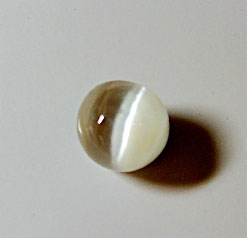 |
| Cat’s eye quartz, 12.27 carats, from the collection of John Sinkankas, now in the personal collection of Bill Larson. (Photo: Valerie San Giacomo) |
Eventually John chose Pala International to sell a fine selection of his gemstones and I kept, among several rare items, the cat’s eye quartz pictured above.
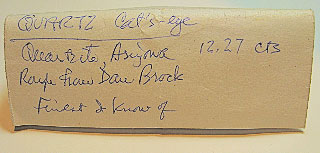 |
| The description accompanying the stone states, in John Sinkankas’s hand, “Quartz Cat’s-eye/ Quartzite, Arizona 12.27 carats/ Rough from Dave Brock/ Finest I know of.” (Photo: Valerie San Giacomo) |
[back to top]
Mineral and Mineralogy News
New Crystal Hunters: DVD
Forthcoming DVD follows youngsters into the mines
The folks at BlueCap Productions have a production in the works: filming blue-capped kids exploring the world-famous mines of the Pala mining district. The idea grew out of interaction with young folk at this year’s Tucson show, when the kids discussed their budding passion for minerals.
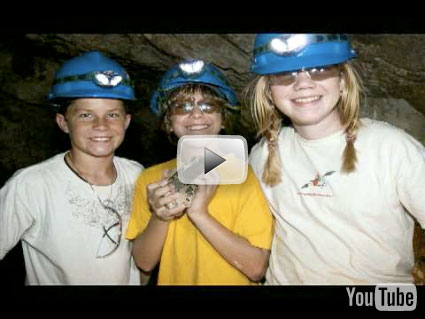 |
In August of this year, ten hours of film were shot during three days of looking over the shoulders of three members of the next generation of mineral enthusiasts: Brooks Albright-Ratnavira, Max Sigerman, and Lauren Megaw (pictured above with a smoky quartz at the Pala Chief Mine). See a preview of stills from the shoot on YouTube. [back to top]
— End December Newsletter • Published 12/8/08 —
October 2008 Newsletter
Shows and Sales
- Pala at Dubai ICA International Gem Show – October 13–15
- terra mineralia in Saxony – October 28–November 2
- What’s Hot In Tucson: Online
Pala International News
Mineral and Mineralogy News
Shows and Sales
Pala at Dubai ICA International Gem Show
October 13–15, 2008
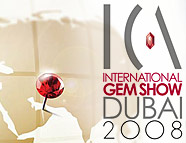 |
Pala International will be at the ICA International Gem Show, which is billed as “the first luxury B2B gem show tailored especially for the loose colored gemstone industry featuring the world’s 120 most prominent colored stone merchants.”
- When: Oct. 13–15, 2008
- Where: Al Bustan Rotana Hotel, Dubai
- Hours:
Mon.–Tue.: 10 a.m.– 9 p.m.
Sun.: 10 a.m.– 7 p.m.
We are pleased to announce that we will be sharing display space with our good friends, the Gobin brothers (who we recently visited at the Sainte-Marie show). Pala will be bringing a selection of our finest colored stones and a collection of exquisite gem crystal specimens. For more information visit the International Gem Show website.
Visit the Pala International Show Schedule for future events. [back to top]
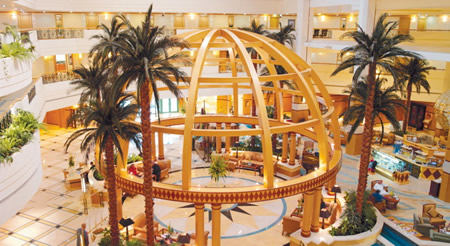 |
| Grand Lobby of the Al Bustan Rotana Hotel, site of the ICA International Gem Show. (Photo © 2007 – Rotana Hotels) |
terra mineralia: October 28–November 2
 |
Saxony Mining Academy Hosts Huge Exhibition of Rare Specimens
Mineral enthusiasts will have six days to view a remarkable exhibition of specimens later this month. “terra mineralia,” which is to be mounted by the famous Technical University of Freiberg in Saxony, “presents for the first time the world’s largest private mineral collection of Swiss foundress Dr. Erika Pohl Ströher,” according to an exhibition press release (in German). The collection, amassed over 60 years of collecting, will be on permanent loan in Germany due to the efforts of Prof. Georg Unland, currently Minister of Finance of Saxony.
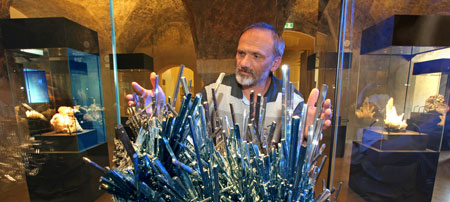 |
| Petrified pincushion. Kustos Andreas Massanek equips a showcase in the “Schatzkammer” (treasure chamber) with an antimonite (stibnite) from China. (Photo: Wolfgang Thieme) |
More than 5,000 minerals, jewels, and meteorites will be displayed in what organizers are calling “a mineralogical voyage around the world.” Indeed, four continent halls—Africa, Europe, America, and Asia—are being filled with over 140 custom-built showcases. Two thirds of the specimens in the exhibition will have no duplicate on display, according to an August 1 press release.
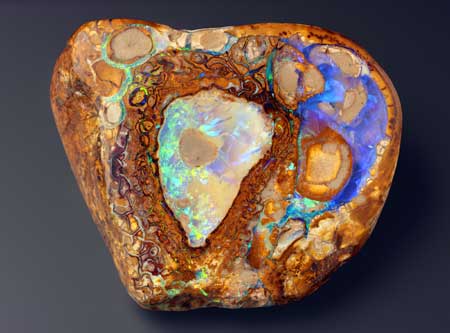 |
| Noble opal from Australia, 6 x 5 cm. (Photo: Jörg Wittig) |
The Museum Castle Freudenstein, site of the exhibition and recently renovated, is itself a work of architectural audacity, as can be seen by this portfolio on AFF Architekten website. The 3,000 square meters of exhibition space, which was completed in January, have been painstakingly crafted since the collection was transferred in 2004 and stored on seven floors of a secure “comprehensive depot.”
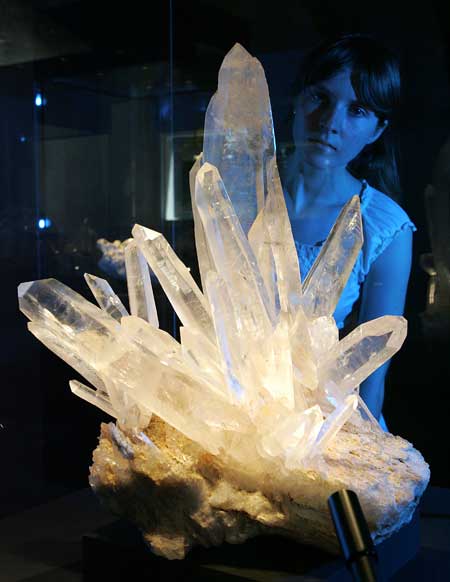 |
| Crystal clear. Above: Denise Hennig of Institute for Mineralogy at the university, regards a rock crystal specimen. (Photo: Detlev Müller) Below: Prof. Gerhard Helde examines a 100-kg. “bred” fluorite crystal. (Photo: Eckardt Mildner) |
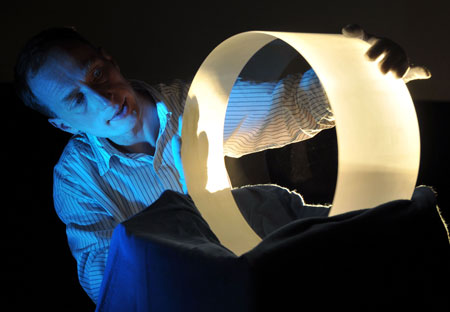 |
Also on display will be a 100-kilogram synthetic, “water-clear” fluorite crystal, created by Schott Lithotec, a developer and supplier of optical components used in lithography technology.
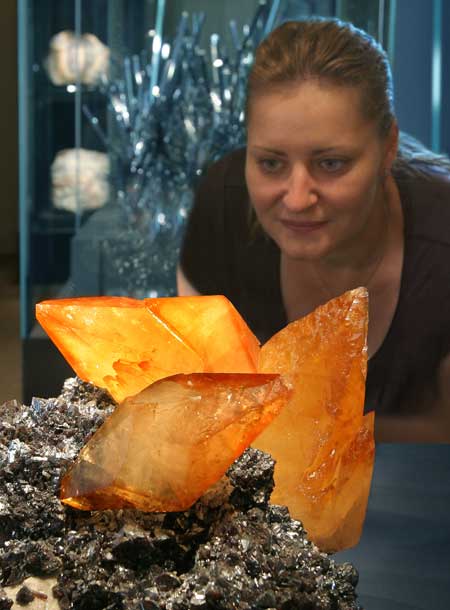 |
| Calcite on zinc from U.S.A. is admired by Manuela Wagner of the university’s Institute for Mineralogy. (Photo: Detlev Mueller) |
The show will include a 3.5-ton meteor exhibit from what is presumed to be the largest impact crater at Vredefort in South Africa. Eight plates of polished “friction-melted” earth from the crater will be on display.
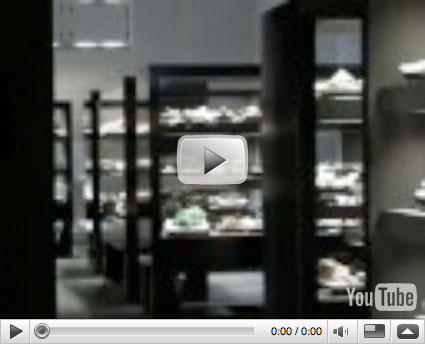 |
| Vault video. Above: Watch as exhibition staff and craftsmen prepare display cases and specimens. Below: Bold new architecture finds its place in the renovated 12th century Castle Freudenstein, site of “terra mineralia.” Its interior was gutted during the Seven Years War and had been used only for storage until the makeover, completed just this year. (Photo: AFF Architekten) |
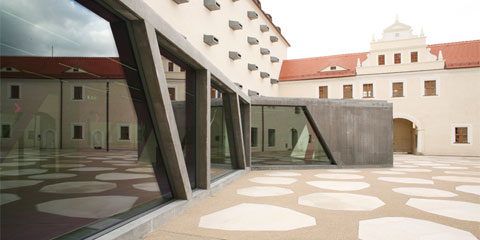 |
For more splendid specimen photos see this Spiegel Online article (translated by Google; original German here).
Also making its debut is Via Mineralia, “a pervasive museum explorative game,” developed by the university’s Virtual Reality and Multimedia Research Group. [back to top]
What’s Hot In Tucson: Online
 |
A new DVD includes extra material from the 2008 show
Since June, BlueCap Productions has offered footage online from this year’s Tucson show—a free supplement to the DVD, What’s Hot In Tucson.
Due to the popularity of this material, BlueCap has collected the footage into a new DVD, What’s Hot In Tucson: Online. This new DVD also includes two segments not offered online.
The new DVD is offered separately, or free to new buyers of the 2008 What’s Hot In Tucson DVD.
Save Ten Percent on Your Entire Order
The producers of What’s Hot are offering friends and associates of Pala a ten percent discount on their entire catalog. Here’s how:
- Visit the BlueCap Productions store and make your selection(s)
- Select Credit Card/PayPal payment method
- During checkout, enter the code palagems into the Coupon area (Note: The Coupon displays late in the ordering process, so be patient)
- Select the Apply Coupon button [back to top]
Pala International News
Pala’s Featured Mineral Specimens: Willemite & Hemimorphite, Mimetite, and Vanadinite
More from the Gabriel Risse Collection
This month we feature a couple more highlights from the recently acquired Gabriel Risse collection. These specimens reflect Risse’s keen appreciation of artistic form, rare composition, and striking contrasts of tone and hue.
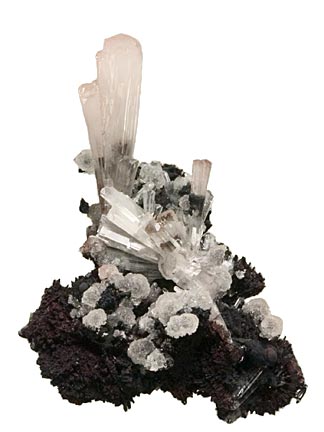 |
| Willemite and hemimorphite on matrix, 9.3 x 6.5 x 3 cm. Inventory #16774. (Photo: John McLean) |
The first specimen is an unusual combination of willemite and hemimorphite on matrix. This specimen comes to us from the Potosí Mine near Santa Eulalia in the state of Chihuahua, Mexico. The hemimorphite’s long, slender prismatic crystals contrast in form to the botryoidal crystals of the willemite with their druzy-like surface. A true sculpture by Mother Earth featuring dark earthy tones of black and brown mixed with lustrous white crystals with just a touch of pink.
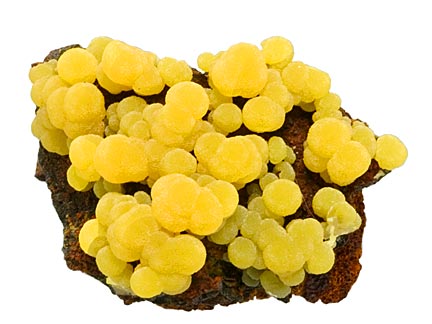 |
| Mimetite on matrix 4.7 x 3.5 x 2.8 cm. This specimen has been sold. (Photo: John McLean) |
The second specimen jumps out at you with bright yellow botryoidal mimetite crystals splashed on brown limonite matrix. This mimetite was found in San Pedro Corralitos, in the state of Chihuahua, Mexico. The separation of the mimetite allows the matrix to create a nice contrast, defining the robust form of the mimetite crystals.
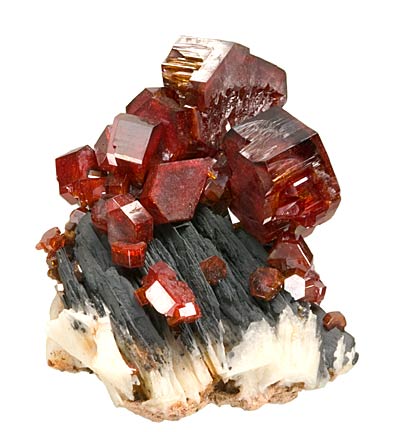 |
| Vanadinite on matrix, 4.3 x 4 x 4.6 cm. Inventory #16780. (Photo: John McLean) |
The third featured item is a very aesthetic specimen with large vanadinite crystals perched on top of a barite matrix. This specimen is from the ACF mine in Mibladen, Morocco. The tabular vanadinite crystals range from 20 mm. to 2 mm., with larger ones taking on some etched and hoppered faces. The vanadinite clusters are sprinkled on top of crested parallel blades of charcoal gray barite with a white base.
Stay tuned for more from the Risse collection or call in inquire about what’s still available. View more from the Risse collection.
Mineral and Mineralogy News
Diamond Crystal Unearthed
Lesotho Diamond Weighs in at 478 Carats
On September 8th a 478-carat rough diamond crystal was discovered in the southern African kingdom of Lesotho. The diamond was unearthed at the Letseng Mine in the eastern Mokhotlong district of the tiny country, which lies completely within the boundaries of the Republic of South Africa.
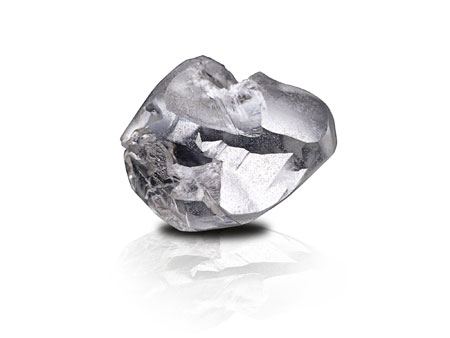 |
| (N)ice… Once it is faceted, this diamond crystal has the potential to be a record setter. (Photo courtesy Gem Diamonds) |
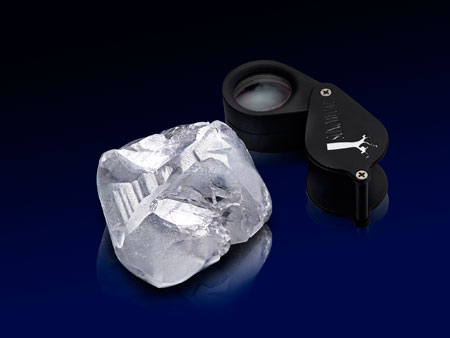 |
The Letseng mine has a rich history of oversized diamonds being pulled from its depths. Since 1920, four of the twenty largest rough diamond recorded have been found at the Letseng mine. It also has been one of the most productive mines throughout its history. This new diamond rough has a chance to set a world record for the finest-quality cut diamond over 100 carats. The color and clarity have been analyzed, revealing a possibility of having a 100-carat-plus D flawless gem.
We will have to wait see what the final faceted stone actually yields.
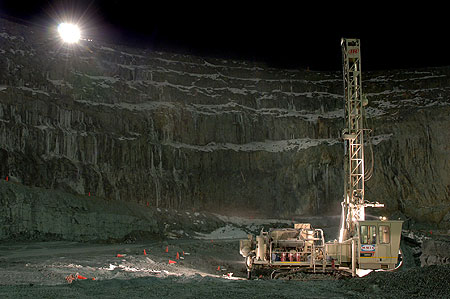 |
| Swing shift. Nighttime drilling takes place in the satellite pit at the Letseng Mine in Lesotho. At 10,000 feet above sea level, it is the highest diamond mine in the world. (Photo courtesy Gem Diamonds) |
The Letseng mine is operated by Gem Diamonds in a partnership with the Lesotho government. It suspended production after De Beers withdrew in 1982. The current operator, Gem Diamonds, acquired the mine in 2006, after it had reopened in 2004 under management by JCI. A Gem Diamonds press release about the unnamed 478-carat rough states that the mine is expected to yield for another 45 years.
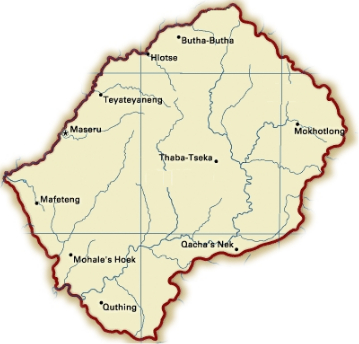 |
| The Letseng Mine is in the Mokhotlong District of eastern Lesotho. (Map courtesy Lesotho Government, Ministry of Communications, Science and Technology) |
- Watch this Reuters video clip on the 478-carat rough diamond
- For a look at the Letseng Mine in 2005, see this Mining Review Africa article
- See also this brief, illustrated report on an August 2007 visit to the mine by a South Africa Student Chapter of the Society of Economic Geologists
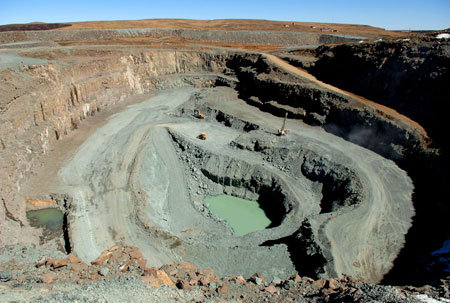 |
| A view of the Letseng satellite pit. The gray material is kimberlite, whose dykes and pipes host the diamond crystals. (Photo courtesy Gem Diamonds) |
[back to top]
“oryctics” Discussion Group
Virtual Museum Starts a Virtual Conversation
Last week we received a note from Paul Tambuyser, co-“curator” with Claude Hootelé of the Virtual Museum of the History of Mineralogy, announcing the launch of the “oryctics” discussion group, hosted by Google Groups. The group is “devoted to the history of mineralogy and crystallography.”
Topics include antiquarian mineralogy and crystallography books, publications and manuscripts, crystallographic goniometers and other antique crystallographic and mineralogical instruments, crystal models, and anything else related to the history of these sciences.
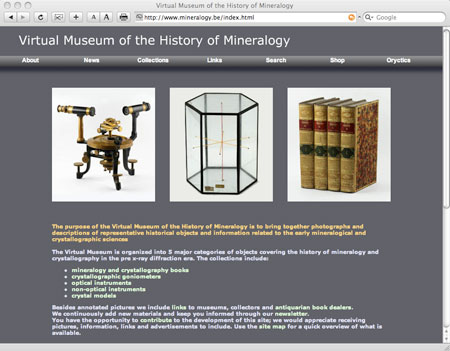 |
The Virtual Museum houses many treasures…
- Mineralogy and Crystallography Books: Dozens of rare titles from the 15th–19th centuries are listed, and include photos of the binding, title page, and representative illustrations
- Goniometers: The history of the development of instruments used for over a century to measure angles between crystal faces
- Optical and Non-Optical Instruments: A collection of microscopes, blowpipe sets, and more
- Crystal Models: It was an incidental discovery during crystal modeling that identified the constancy of interfacial angles in crystals, now known as Steno’s law
Also offered is a list of selected links, and classified ads for such items as that copy of Steno’s De Solido intra Solidum Naturaliter Contento that you always meant to pick up. [back to top]
— End October Newsletter • Published 10/9/08 —
August 2008 Newsletter
Shows and Sales
- Pala at Colorado Mineral & Fossil Show – September 10–14, 2008
- Pala at Dubai ICA International Gem Show – October 13–15
- Tailgating—French Style: Sainte-Marie-aux-Mines 2008
- The Marshall Collection Auctioned by Stack’s
Pala International News
- Pala’s Featured Mineral Specimens
- The Gabriel Risse Collection
- Pala District Reveals Some New Jewels
Mineral and Mineralogy News
Special Feature
Shows and Sales
Pala at Colorado Mineral & Fossil Show
September 10–14, 2008
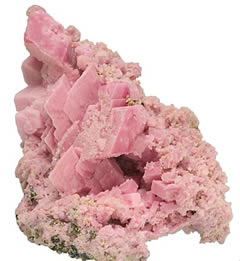 |
| Rhodochrosite from Sunnyside Mine in Colorado, 5.4 x 8.6 x 4.9 cm. This specimen is available. (Photo: John McLean) |
Pala International will be at the Colorado Mineral & Fossil Show.
- When: Sept. 10–14, 2008
- Where: Holiday Inn Denver–Central, 4849 Bannock St.
- Room 183
- Hours:
Wed.–Sat.: 10 a.m.– 6 p.m.
Sun.: 10 a.m.– 5 p.m.
We look forward to seeing our many friends there. For more information visit the show website.
Visit the Pala International Show Schedule for future events.
Note: We are exhibiting the Risse Collection specimens for the first time at this show. [back to top]
Pala at Dubai ICA International Gem Show
October 13–15, 2008
 |
Pala International will be at the ICA International Gem Show, which is billed as “the first luxury B2B gem show tailored especially for the loose colored gemstone industry featuring the world’s 120 most prominent colored stone merchants.”
- When: Oct. 13–15, 2008
- Where: Al Bustan Rotana Hotel, Dubai
- Hours:
Mon.–Tue.: 10 a.m.– 9 p.m.
Sun.: 10 a.m.– 7 p.m.
We are pleased to announce that we will be sharing display space with our good friends, the Gobin brothers (who we recently visited at the Sainte-Marie show). Pala will be bringing a selection of our finest colored stones and a collection of exquisite gem crystal specimens. For more information visit the International Gem Show website.
Visit the Pala International Show Schedule for future events. [back to top]
Tailgating—French Style
Sainte-Marie-aux-Mines 2008 – Bill Larson Reports
It was June 2008 and time for Bill Larson’s favorite European show, Sainte-Marie-aux-Mines. This year they were a group of five men—Bill, his two sons Will and Carl, friend Ben Sobczak, and Bill’s friend and fellow gem dealer Mark Kaufman.
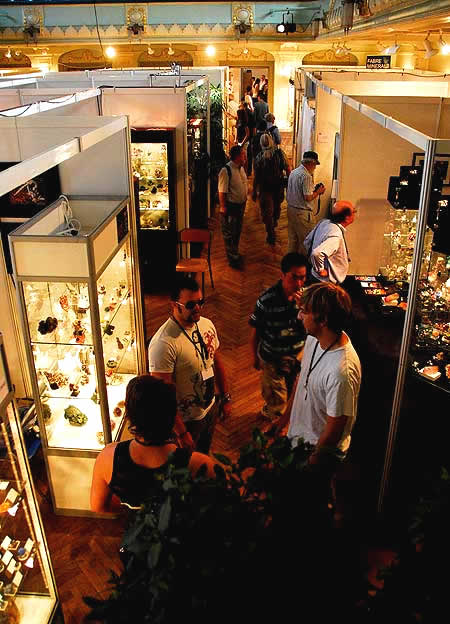 |
| Parked. Will Larson (in stunner shades), Ben Sobczak, and Carl Larson discuss their next moves on the parquet floor of the local theatre, in which the finest specimens are on offer in l’Espace Prestige. (Photo: Bill Larson) |
The show’s highlights included:
- Bill’s purchase of a single crystal of Chinese calcite, so fine it may be featured in a local mineralogical journal
- A featured exhibit, the mines of Chessy, in the Rhône region of France, to which Bill contributed 14 pieces from his own collection
- A “great green fluorite from Namibia…on a large quartz that has color-center phantoms—truly superb and new to my eyes"
- Larger-than-normal jeremejevite crystals from Erongo, Namibia
That’s just Day One. Read the full story here. (And find out what’s behind the title of this feature.)
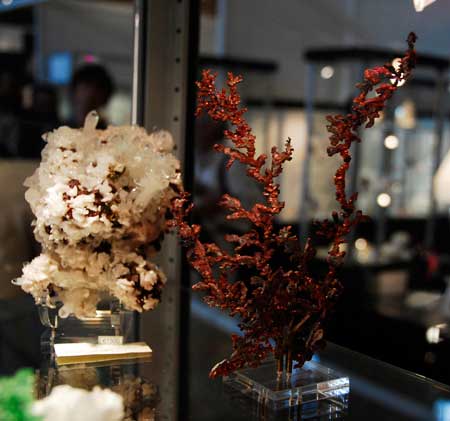 |
| An aesthetic copper crystallized wire, reminiscent of coral. (Photo: Carl Larson) |
[back to top]
The Marshall Collection Auctioned by Stack’s
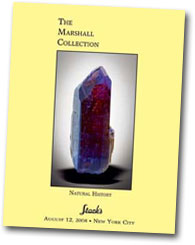 |
Lifelong collector parts with some of his treasures
Next Tuesday, August 12, the New York numismatic auction house Stack’s will feature the sale of The Marshall Collection, the result of a 64-year passion that grew to 4,000 specimens, according to the sale catalog.
The collection includes over 700 lots of minerals, gemstones, meteorites, fossils, decorative arts, and more. Featured in the sale are several pyromorphites, which according to the catalog, were especially close to the heart of the 77-year-old collector since stumbling upon the species in a mine dump near Philadelphia.
The catalog can be viewed and searched lot-by-lot or browsed and searched via an eCatalogue. [back to top]
Pala International News
Pala’s Featured Mineral Specimens: Pyromorphite, Tourmaline on Quartz, and Rhodochrosite
Culled from the Gabriel Risse Collection
This month we feature three new specimens from the new Gabriel Risse collection acquired by the Larson boys at this year’s Sainte-Marie-aux-Mines show in France.
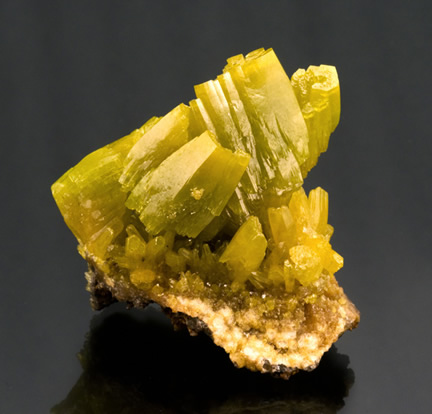 |
| Pyromorphite specimen, 3.9 x 3.4 x 2.5 cm. This specimen has been sold. (Photo: Wimon Manorotkul) |
The first piece is a superb miniature pyromorphite specimen from the Bunker Hill Mine in Kellogg, Idaho. Classic rounded barrel hopper crystals with cavernous centers. Vivid greenish yellow color with one main crystal surrounded by various size intersecting crystals. This is a specimen you just keep spinning in your hand to see all the great angles and details.
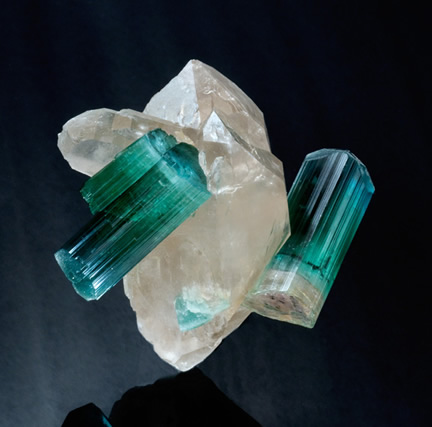 |
| Tourmaline on quartz specimen, 6.5 x 6.5 x 3.5 cm. This specimen has been sold. (Photo: Wimon Manorotkul) |
The second piece is a completely unique tourmaline on quartz from Paprok, Afghanistan. The two tourmaline crystals are so gemmy, with a neon greenish-blue hue, that it would make any cutter drool with temptation. One crystal is doubly terminated with a subtle gradation from bluish green to greenish blue with a frosted pyramidal cap. The other crystal is thicker with a cleaved pink-and-white bottom and an upper half that is virtually flawless. If that weren’t enough, the two beautiful tourmalines are naturally attached to a doubly terminated quartz crystal.
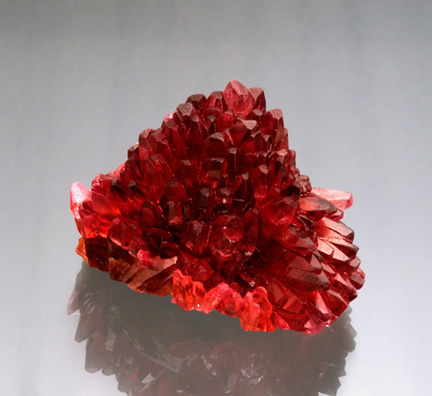 |
| Rhodochrosite specimen, 4.1 x 3.1 x 2.8 cm. This specimen has been sold. (Photo: Wimon Manorotkul) |
The third specimen is an exquisite rhodochrosite from N’Chwaning, South Africa. Reminiscent of “The Snail,” this miniature is a radiating cluster of individual scalenohedron rhodochrosite crystals. The specimen glows from the heart with an intense red hue when backlit, almost revealing its near-flawless interior. [back to top]
The Gabriel Risse Collection
Pala acquires 130 fine mineral specimens
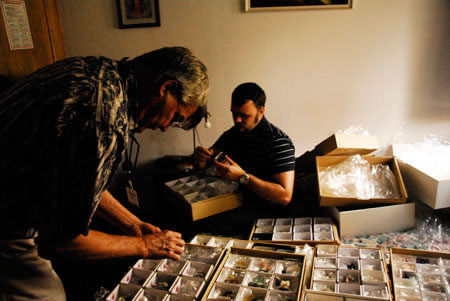 |
| The Larson boys—Bill (left), Will, and Carl (not pictured)—sort through the flats evaluating and calculating the feasibility and desirability of the collection. (Photo: Carl Larson) |
Bill Larson recalls meeting Gabriel Risse twenty years ago when Risse was a ripening 18-year-old mineral collector in Europe. Their sporadic relationship over the decades culminated at this year’s Sainte-Marie-aux-Mines show in France.
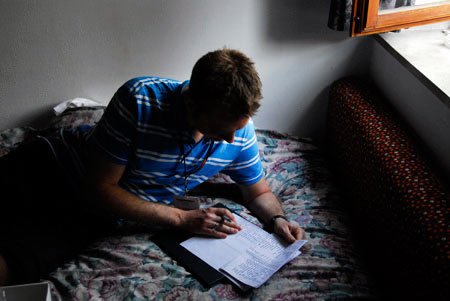 |
| Gabriel Risse checks his list to see if the Larsons’ offer will suffice. (Photo: Carl Larson) |
Since those early days of collecting, Gabriel had amassed an exquisite mineral collection with over 150 pieces, mostly in the small cabinet to miniature sizes—all beautifully representing the best formations and aesthetics from most of the great localities around the globe. From gem crystals to metals to carbonates, this full-spectrum collection seems to focus on crystal perfection, unique morphology, and artistic form.
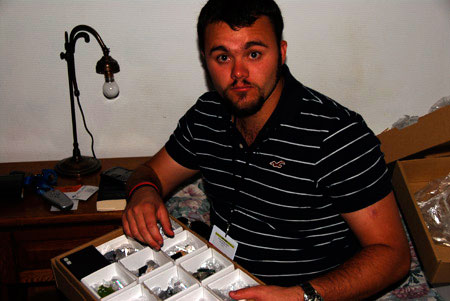 |
| Will Larson, momentarily distracted from the matter at hand. (Photo: Carl Larson) |
The collection encompasses many species and highlights fine examples within each category: pyromorphite from Idaho to vanadinite from Morocco…calcite from Sweden to rhodochrosite from South Africa…tourmaline and kunzite from Afghanistan to epidote from Austria…aegirine from Malawi to hemimorphite with willemite from Malawi…carrolite from Congo to calcite from Kazakhstan…ilvaite from Russia to topaz from Pakistan. See this month’s featured specimens and Wimon Manorotkul’s FotogFocus for a sample.
A venture through the Gabriel Risse collection is an in-depth and colorful ride through the realm of exquisite mineral specimens.
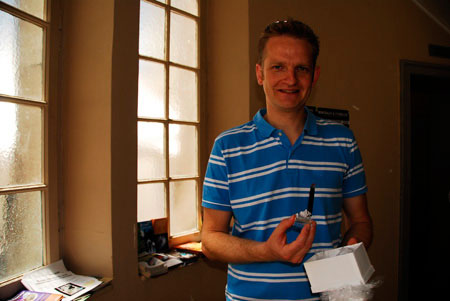 |
| Old rocks out; new rocks in. Gabriel Risse smiles from enjoyment following the first purchase of his new collection. (Photo: Carl Larson) |
The deal went down in a hotel room in Sainte-Marie-aux-Mines. Bill hand-carried the thirty most fragile specimens back, and Gabriel took a special trip to San Diego, delivering the last 100 pieces, finalizing the deal, and checking out the Pala operations.
We are now processing all the specimens, getting them ready for an unveiling in Denver. [back to top]
Pala District Reveals Some New Jewels
Kunzite from the Elizabeth R. Mine
A recent find at the Elizabeth R. mine, in the Pala mining district, revealed some spectacular kunzite crystals. The crystal formation is not very well defined but some of the pieces are facet-grade and hold a beautiful natural color. The color is verifiably natural since we can actually trace the kunzite directly from the mine. This batch of kunzite takes on an extremely intense purplish-pink hue. The condition of this material is slotted for a trip to the cutter. Stay tuned for some intense faceted kunzite to be produced from this rough.
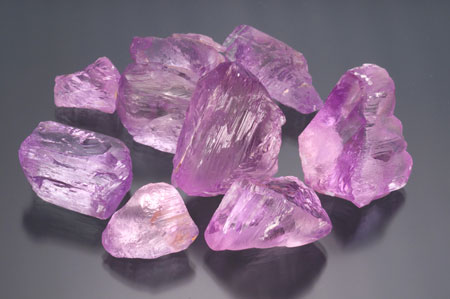 |
| Pure, purple, pink. Some of the facet-grade material produced by the Elizabeth R. (Photo: Wimon Manorotkul) |
The Elizabeth R. mine is situated just above the Oceanview mine which we have been reporting on recently. See the below links to read more about the other recent finds in the Pala Mining District. [back to top]
Mineral and Mineralogy News
Working the Blue Seam: The Tanzanite Mines of Merelani
Vincent Pardieu, Richard W. Hughes, et al. go down
the rabbit holes of Merelani’s Block D
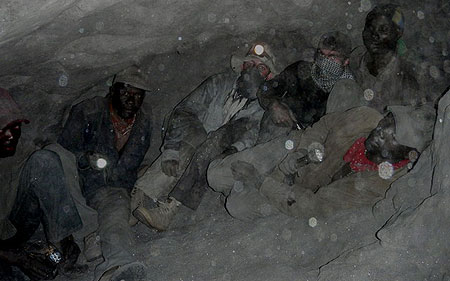 |
| Graphite grunge. Guillaume Soubiraa and Philippe Brunot (center left and right) in the tight confines of a tanzanite mine at Merelani's Block D, along with local miners. (Photo © Vincent Pardieu) |
In April, we reported on miners trapped and killed in the mines of Tanzania’s Merelani mining district. Six months before this tragedy, an international group of adventurous gemologists and fellow travelers wiggled and wriggled down the rabbit holes of Merelani’s labyrinthian mines in Block D, which is operated by independent, artisanal miners. It is in D’s sister sector, Block B, where the miners perished due to seven days of torrential rain.
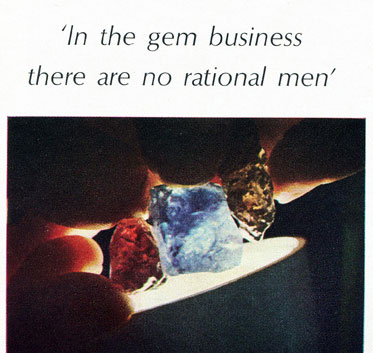 |
| Three rough pieces of zoisite rough being analyzed. From an article published May 1969, at the time of tanzanite’s initial discovery. |
“Working the Blue Seam: The Tanzanite Mines of Merelani,” by Vincent Pardieu and Richard W. Hughes, with five other contributors, begins with the 40-year history of the mines in the Merelani hills that are situated in the shadows of Mount Kilimanjaro. The article discusses the science of this variety of the color-shifting species, zoisite, including the geology of region. Finally, the band of keffiyeh-clad cronies—dubbed “the insane gem posse”—shimmy down shafts that, with any luck, have blue at both ends.
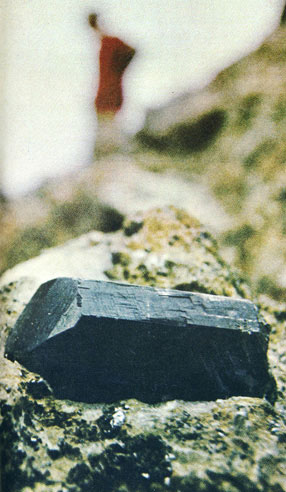 |
| Stocky tanzanite crystal on matrix. I wonder where this piece ended up. From the May 1969 article. |
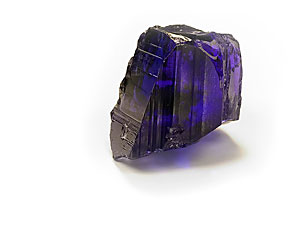 |
| Shifty. Tanzanite is strongly pleochroic, appearing to be different colors depending on the light source and the axis viewed. From the article “Working the Blue Seam.”(Specimen: Bill Larson; Photos: Wimon Manorotkul) |
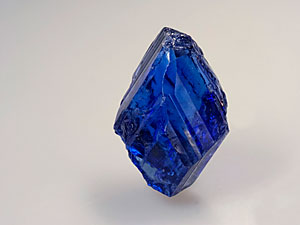 |
[back to top]
Special Feature
FotogFocus: Wimon Manorotkul – In Love with Aesthetics
A look at the artist behind the camera
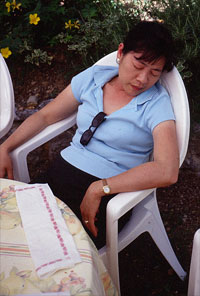 |
| Title: Self-portrait with serviette. Wimon Manorotkul will get a well deserved rest when she leaves Pala International next month. |
Wimon Manorotkul has been photographing gemstones and mineral specimens for Pala International ever since Richard W. Hughes developed Palagems.com, which debuted in late February 2000. At first the photographs simply filled a need: if you’re going to offer an online catalog, you better include photos of what you’re selling. So prior to the launch of Palagems.com, Wimon set about photographing the inventory.
As a gemologist—she’s an FGA (elected to the Fellowship of the Gemmological Association of Great Britain)—enjoys gem testing and photomicrography. “I just love the aesthetic qualities of gemstones at high magnification,” she says.
Departure(s)…
Now, after seven years of helping Pala clients in their quest for that perfect gemstone, Wimon Manorotkul is leaving Pala, and together with her husband Richard W. Hughes they are going home—to Wimon’s native Thailand, where the couple first met. We wish both of them all the best, but before she leaves us, we’re pleased to feature Wimon Manorotkul as the third artist in our occasional series, FotogFocus.
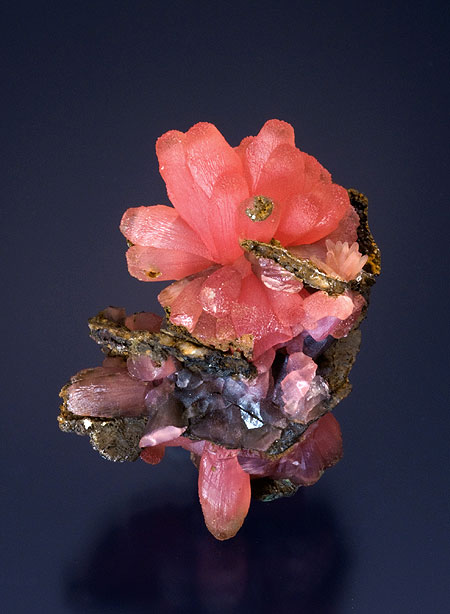 |
| Still life. This rhodochrosite “blossom,” 3.5 cm. tall, is from the Wolf Mine, Betzdorf, Siegerland, Germany. (Photo: Wimon Manorotkul) |
In this installment of FotogFocus, we get to know Wimon a little better, but we also see the most recent efforts of her talent. Included are photographs, just taken, of selected specimens Bill Larson acquired at this year’s show at Sainte-Marie-aux-Mines, from the Gabriel Risse Collection: a lovely Peruvian selenite and the snail-like adamite from Mexico.
Also included are photographs taken by Wimon for the sixth annual John Sinkankas Symposium, held in April. The subject of the conference was garnet, and Wimon’s images show the spectacular variety of this species. See it all in FotogFocus. [back to top]
— End August Newsletter • Published 8/7/08 —